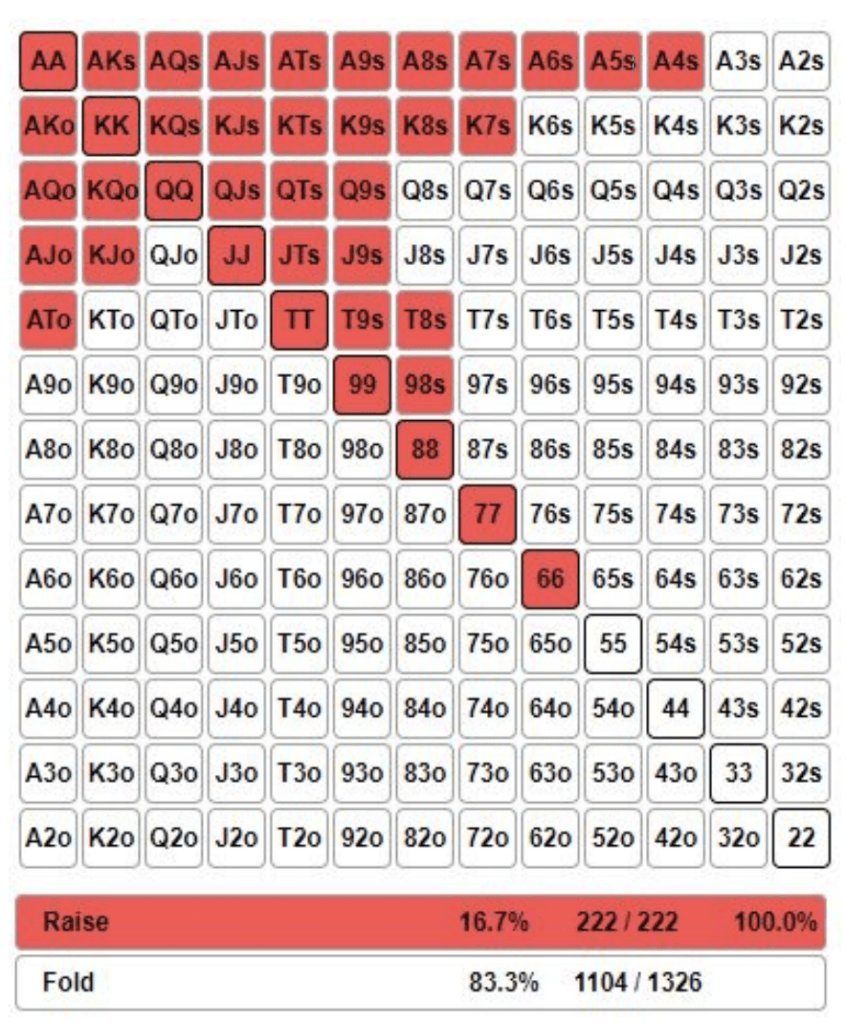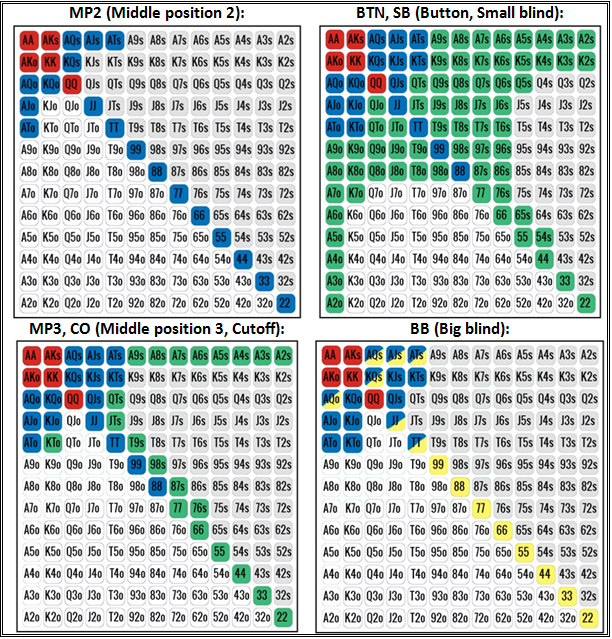Texas Holdem Poker Pre-flop Strategy Chart
The most important move you’ll make as a player in online Texas Hold’em poker game is your play preflop. In football, everything revolves around the quarterback. In baseball, it’s the pitcher. These are the players who initiate every play – the ball is in their hands. What they decide to do with it will determine who wins and who loses the games.
It’s the same thing in Texas Hold’em poker. You’re the quarterback now; you’ll get your hole cards, and when it’s your turn, you will initiate by either raising, calling or folding. It’s the ultimate “choose your own adventure” game. We’ll show you how to make the best choices possible during the critical pre-flop stage. The following concepts and strategies will help you improve your poker betting decisions before the flop, giving you the best chance of success on every street that follows.

Preflop Play in Texas Hold'em
The great thing about pre-flop is that it’s also the easiest street in poker games. Nothing too complicated has happened yet – your “decision tree” hasn’t grown too many branches. This means you can focus on the three things that matter most:


All the lessons from the Poker Basics course remain relevant when playing a no limit Texas Hold’em cash game, and you should look back to refresh your memory. In short, your decisions in the pre-flop betting round should be based on three key factors. In the three previous lessons we have built on the Poker Basics course and focused specifically on correct pre-flop play in no limit Texas Hold'em cash games. There's a lot of information to process, so here is a summary of all those essentials, as well as a chart that you can print out and keep handy for cash game play. The Pre flop strategy is something through which you can bring changes in your Texas Hold’em games. The people on a table who should see the flop should be around 30% or if it is 20 heads then only 2-3 should be seeing the flop. Click for information on history, terminology/glossary, hand rankings/nicknames and holdem pre-flop chart. The Sequence of Play in Texas Hold'em Poker. The first step in any game is to establish a betting structure. In some instances blinds will be used, and in other instances antes will be.
- Your hand
- Your position at the table
- The other players and the way they play
Depending on which Texas Hold’em game you’re playing (tournament or cash game, full-ring or short-handed, etc), all the decisions you make pre-flop should boil down to these three essentials. The strength of your hole cards will play the biggest role in determining when to bet in poker. Your position will affect how strong your hole cards have to be in order to raise, call, or fold correctly. And, you’ll tailor your decisions to account for your opponents and their specific style.
How to Play Your Hand Preflop
Texas Holdem Poker Pre-flop Strategy Chart Template
You may have heard this old chestnut before: Don’t play the cards, play the player. There’s some truth to that – as we’ll discuss shortly. Here’s another saying: Don’t bring a knife to a gunfight. Your chances of success in any Hold’em hand go up by leaps and bounds when you’re dealt quality hole cards.
That’s why it’s so important for newer players to learn the relative strength of the different starting hands in Hold’em. You can’t figure out how to bet in poker (or raise, call or fold) without getting this fundamental aspect of the game down pat. As it turns out, there are 1,326 possible starting hands in Hold’em, but don’t worry; during the pre-flop stage, the suits are pretty much irrelevant, aside from whether your two cards share the same suit or not. That means you have only 169 starting hands to consider. Let’s start at the top with the best of the bunch.
PLAY POKER NPremium Hands
As you probably know, the best possible starting hand in Hold’em is pocket Aces. You’ve already got a “made” hand, meaning a pair or better. And it’s the best possible pair. But how do you measure the strength of AA? One easy way is to pretend you and a single opponent go all-in pre-flop, and the other players has two random cards from the remaining deck of 50. The math says that your Aces have 85.20% equity, meaning you’d win 85.20% of the pot in the long run if you played this scenario over and over again. This is known as “hot-and-cold” equity in poker parlance.
The next strongest hand in Hold’em is pocket Kings. You certainly don’t want to run into pocket Aces when you go all-in, but against every other hand, you’re in great shape; KK has 82.40% equity against two random cards. The remaining “big” pocket pairs are also very strong:
- QQ: 79.92%
- JJ: 77.47%
- TT: 75.01%
Yes, even those tricky pocket Jacks and pocket Tens should make you happy when you see your hole cards. Once you get beyond the big pairs, the next hand on our power rankings is Ace-King suited. You don’t have a made hand yet, but if you catch an Ace or a King on the flop, you automatically have Top Pair-Top Kicker (TPTK). You also have two cards to the highest straight possible, the “Broadway” straight (AKQJT). Since your hand is suited, you also have two of the five cards you need to make a flush. This powerful starting hand has 67.04% equity versus two random cards.
Here are the remaining starting hands that are generally considered “premium” in Hold’em:
- AQs: 66.21%
- AKo: 65.32%
- AQo: 64.43%
Other Hands
Even if you don’t receive one of these premium hands pre-flop when you play online poker, you’re still in good shape if you get dealt a medium pocket pair (Nines through Sixes). In fact, you’ve got more hot-and-cold equity with many of these pairs than you do with Ace-King or Ace-Queen:

- 99: 72.06%
- 88: 69.16%
- 77: 66.24%
- 66: 63.28%
What can we tell you: It’s hard to make a pair in Hold’em. The trick with these medium pairs, or baby pairs (Fives through Deuces) for that matter, is in how you play them – they don’t have as much versatility as a hand like Ace-King. Most of the time when you play Hold’em, you won’t be going all-in preflop. You’ll be in a lot of single-raised pots (where someone open-raises and someone calls), and the more community cards that come out, the less powerful these non-premium pairs become.
Then again, the more cards you see post-flop, the more chance you have of winning with a suited connector. Ace-King suited is the strongest of these, but even a hand as low as Nine-Eight suited can pack quite a punch:
- KQs: 63.40%
- QJs: 60.26%
- JTs: 57.53%
- T9s: 54.03%
- 98s: 50.80%
That’s the power of the suited connector. There can be plenty of value with other hands like non-suited connectors (AKo is the best) and suited one-gappers (AQs) and so on. But your starting hand will become less powerful as the two cards get lower and more disconnected. Eventually, you’re down to the worst starting hand in Hold’em: Seven-Deuce offsuit. But even this trash hand has 34.58% equity against two random cards. So we’re saying there’s a chance.
The Impact of Your Position Preflop
As we mentioned earlier, deciding how far down this list you’re willing to go pre-flop will depend on your position at the table. If you’re sitting under the gun at a full-ring cash game, you have eight players waiting for you to act, which means you’re running the gauntlet – this is not an ideal time to wade in with a weaker hand. But if the action folds around to you in the button, now you only have the two players in the blinds to worry about. This gives you the freedom to open-raise a much wider range of hands.
We should note at this point that open-calling (aka “limping in”) is not a recommended Hold’em strategy for beginners, or just about anyone. When you open-raise, you give yourself the chance of winning the pot uncontested pre-flop when everyone else folds. Calling instead of raising allows the blinds to see the flop for free. Save that play for the experts.
What if someone bets first before it’s your turn? Now you’ll need both a raising approach and a calling strategy. It still matters how many players are left to act behind you, but it also matters where the open-raiser is seated – remember, they’ll probably have a tighter range in early position, and a weaker range in late position. Keep that in mind when you’re deciding whether to fight back.
If you happen to be in the blinds, since you’ve already thrown a few chips into the pot, you’ll have the right odds to call with a wider range of hands than at any other position. But if you’re in the small blind, calling is once again not generally recommended. You’re guaranteed to act first post-flop, and being out of position is a considerable disadvantage. Calling from the big blind is different; you get even better odds to make that call, so you can often get in there and mix it up with otherwise weak hands like Eight-Four suited (42.70%), especially when the open-raiser is in late position.
Paying Attention to Other Players
As you can see, there’s a certain mathematical structure to Texas Hold’em. By comparing the strength of your hand (and your perceived range, if you’re an expert) to the strength of your opponents’ likely ranges, the size of the bets in question, and the number of players left to act, you can make the best possible decision with every hand you play. Poker wizards have used computers to help figure these decisions outlook on the internet for reliable pre-flop charts that you can use as training wheels when you’re at the online tables.
But don’t forget about the other players. They’re not necessarily going to play the way the charts recommend. Some will have tighter ranges that you can exploit by bluffing more and calling less. Others will have looser ranges that you can exploit by bluffing less and calling more. Combined with solid poker bankroll management, these adjustments (and others) are the key to long-term success at the tables. Think of the math as your shield, and the exploitative adjustments as your sword. Watch the other players, learn their habits, find their openings, and strike when the time is right. That’s how you rule the pre-flop streets in Texas Hold’em.
Certainly the most popular form of poker that is found in poker and tournaments today is Texas Hold'em. This community type card game is hugely sought after around the world, and is especially popular in the United States. Major tournaments such as the World Series of Poker, where no limit Texas Hold'em is offered, have played a huge role in the advancement of this poker variant in recent years.
Learning Texas Holdem Poker Strategy
The objective of Texas Hold'em Poker is to complete the game with the best possible poker hand in order to take home the prize pot. While Texas Hold'em is considered simple to learn, with an easy to follow betting format, players need to hone their skills and practice their strategies before they are ready to sit down and play at professional games or tournaments. Click for information on history, terminology/glossary, hand rankings/nicknames and holdem pre-flop chart.